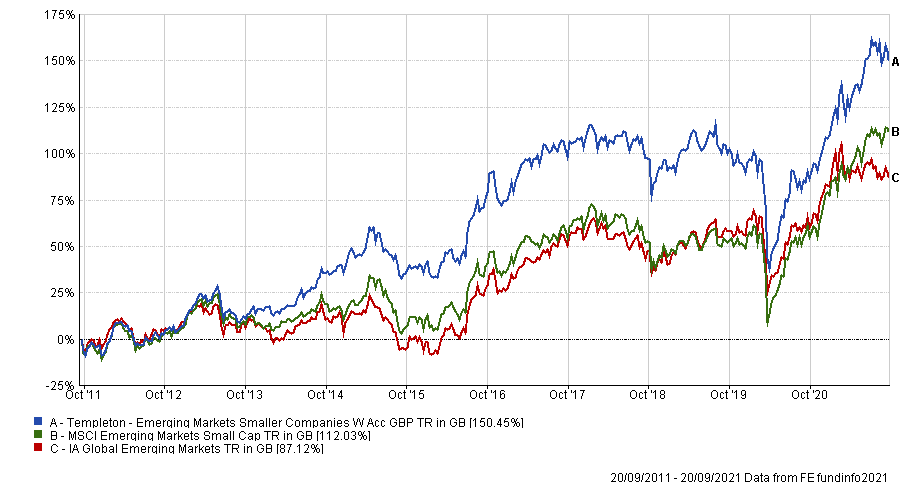Just one fund out of six regional equity sectors made top-quartile returns over the past 10 years after falling into the bottom quartile for suppressing maximum drawdown.
This is the final story in the series looking at which funds have consistently delivered returns in the top 25% of their sector while hit with a fourth-quartile maximum drawdown. The study previously looked at UK, global and Asian sectors.
For the conclusion, the study looked at the remaining regional sectors: IA North America, IA North America Smaller Companies, IA Europe ex UK, IA Europe inc UK, IA European Smaller Companies and IA Global Emerging Markets.

Source: FE Analytics
The only fund to make the list was Templeton Emerging Markets Smaller Companies, which is in the IA Global Emerging Markets sector. The fact it was the only one highlights the importance of downside protection to outperformance.
The fund had 77 positive months out of a possible 120. It made 146.8% in total returns over the past decade, the 10th highest return in the sector, with a maximum drawdown of 35.3%.
Performance of fund vs sector and index over 10yrs

Source: FE Analytics
In comparison the fund’s benchmark, MSCI Emerging Markets Small Cap Index, had a maximum drawdown of 32.5% over the same timeframe, but had fewer positive months, at 70. The maximum drawdown for the sector was 21.7%.
At 20.25%, the fund was also in the fourth quartile of its sector for suppressing volatility over the past decade.
Tom Sparke, GDIM investment manager, said that this volatility was expected, given the combination of investing in small caps in less developed regions. But he said that the “outsized returns have justified this level of volatility”.
Templeton Emerging Markets Smaller Companies was launched in 2011 and has been run by Chetan Sehgal since 2017.
Sehgal became the lead manager after Dr Mark Mobius stepped down from Franklin Templeton Investments in 2018. Sparke called Mobius a “talismanic” manager who was renowned for emerging markets investing. After leaving, Mobius set up Mobius Capital Partners with Carlos Hardenberg, running a fund and a trust in a similar style to the one they used on Templeton Emerging Markets Smaller Companies.
Sehgal uses a value-focused process, with little in the way of top-down analysis. Rayner Spencer Mills said that its focus on small caps makes it a fund “for the long term”.
“Smaller companies are expected to grow over time and patience on an investor’s part would see that the fundamentals of a particular business come to the fore,” it said.
The group added that periods where fundamentals drive markets will see the fund perform well, while more sentiment-driven markets or periods of supply and demand imbalances could see it struggle
“The manager views the latter as unsustainable and only providing a short-term tailwind, and that the fund’s focus should be on sustainable growth opportunities,” Rayner Spencer Mills said.
This has led Sehgal into names such as Indian investment firm Bajaj Holdings and Investment, German bike engineer Merida Bikes, home furniture brand Zinus and semiconductor manufacturer LX Semicon.
The fact that a value-focused fund has outperformed during a decade when markets and investors have favoured growth arguably speaks to the longevity of the fund’s process.
The $549.8m fund has an ongoing charges figure (OCF) of 1.49%.





